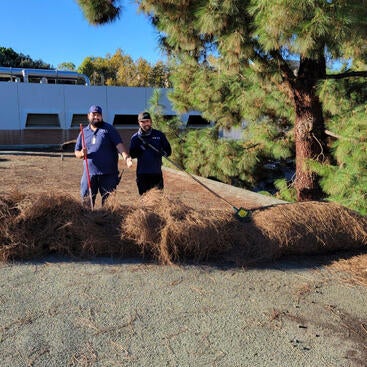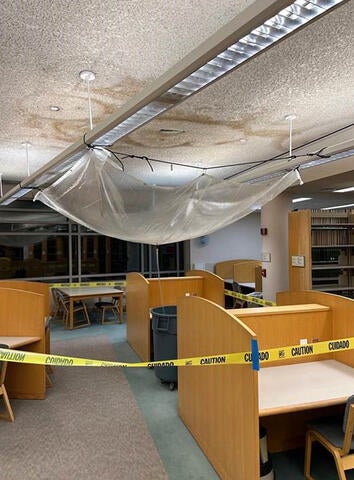
This winter, unrelenting rain drenched southern California from a series of severe cold-weather storms and put many areas on alert for floods, mudslides, sinkholes, and rescues. While the intense rainstorms shattered long-standing records, Facilities Services planned ahead for the campus and responded to calls during the course of the heavy weather.
Toshio Ishida, who serves as the assistant director of Landscape Services, has his team plan early. “We start roof cleaning in October and it takes our crew about three to four months to get through all the roofs,” he said. This is conducted annually to prevent clogged drain pipes, and this year they collected over 9,000 pounds of rooftop debris.

His team also places roughly 500 sandbags around campus for rain control and will change some of them throughout the winter as needed. “We usually go through about 800 sandbags a year,” Ishida said.
If rain is in the forecast, the landscape team checks and attempts to clean exterior building drains in advance. Groundskeepers are directed to monitor their drains and sandbags on rainy days.
In addition to landscape clean up, the plumbing shop took a proactive approach to cleaning the drain systems this year. Superintendent Chris Pillen knows water can be damaging to buildings. “Whenever we experience heavy or long periods of rain, we know we will have many roof leaks to contend with,” he said.
“What we did not experience with this last event was storm drain flooding. This is due to the preventative maintenance program we put together to hydro jet and vacuum known-problem areas of our storm drain systems,” Pillen said.
Roof leaks, on the other hand, will still occur. For Chad Chambers’s carpentry team, “It is all hands on deck. Everyone is responding to calls.” If there is a leak, “They will go up on the roof and will try to slow it down until it stops and that’s when we can patch it.”

As soon as there is a break in the rain and it is dry, they will work on patching the roof and call upon contractors if needed. After a roof is patched, it must be tested before the interior ceiling tiles can be replaced. Sometimes testing requires a few weeks, leaving ceilings exposed for onlookers during the wait.
If there is significant water intrusion, carpenters will work alongside custodial staff and place carpet blowers and dehumidifiers to address areas needing attention.
The custodial team plays an integral role in triaging building damage by quickly responding to calls to extract water from buildings and clean up debris. During the recent storm, they cleared away water from the fourth floor of Leon Dextor Batchelor Hall, from a break room and a fourth-floor office of W. Conway Pierce Hall, and from the second and third floors of Tomás Rivera Library. They also placed containers to catch water in the Genomics Building and Herman T. Spieth Hall pending restoration.
Aaron Uresti, the assistant director of Custodial Services & Resource Management, oversees the custodial team and values their commitment of assistance. “Kudos to our staff that came on campus during winter break and the MLK holiday weekend to address these emergencies and help mitigate water-related damage to our campus buildings.”
With heavy meteorological conditions anticipated in the coming months, Facilities Services continues to look for ways to maintain buildings, facilities, and landscapes for the safety of the campus community.